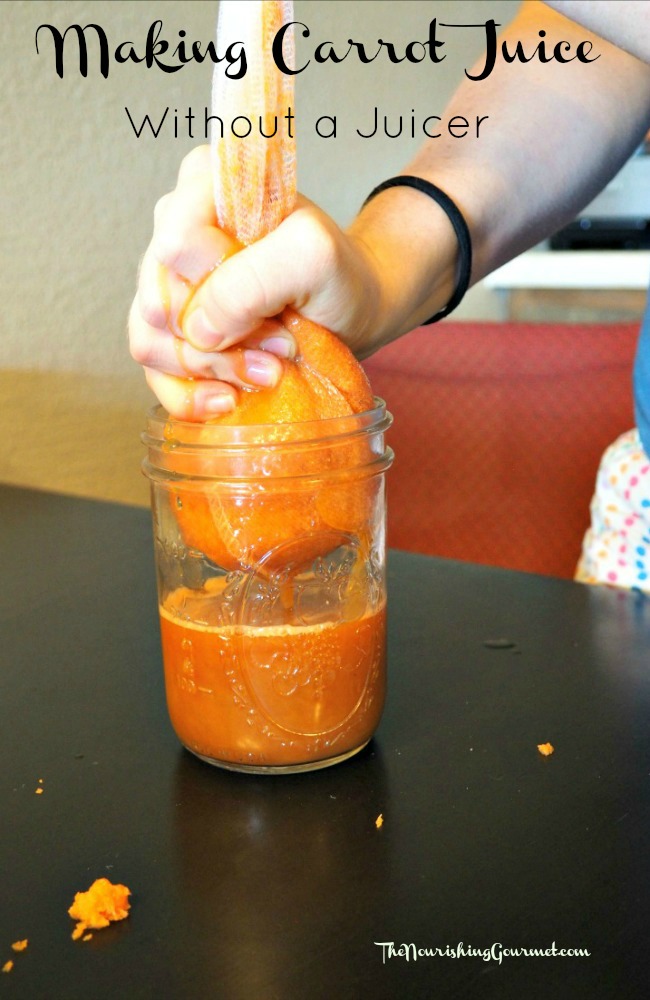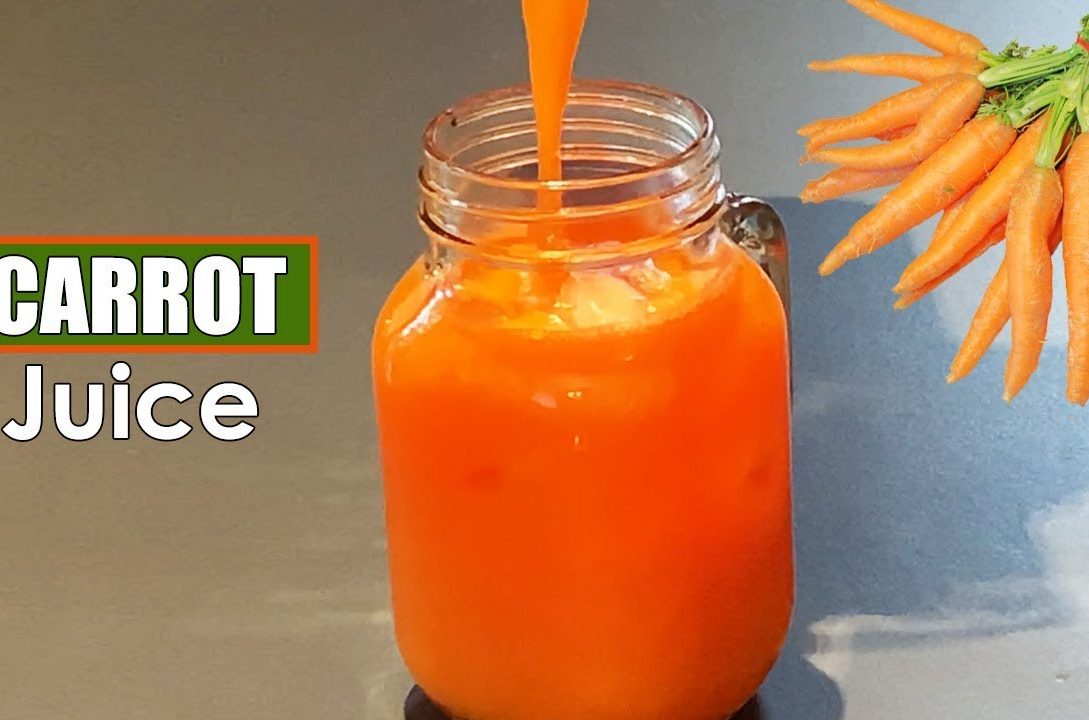To juice carrots without a juicer, you can use a blender or food processor. We will explore the steps to juicing carrots without the need for a juicer, allowing you to enjoy fresh and nutritious carrot juice at home.
Carrots are packed with essential vitamins and minerals, and juicing them is a great way to incorporate their benefits into your diet. While juicers are a popular choice for extracting juice from carrots, not everyone has one readily available. Thankfully, there are alternative methods that can achieve similar results.
In the following sections, we will discuss two common methods: using a blender and using a food processor. Both options are relatively easy and require minimal equipment. So let’s dive in and learn how to juice carrots without a juicer!

Credit: www.thenourishinggourmet.com
How To Juice Carrots With Common Kitchen Tools
Juicing carrots without a juicer is simple with common kitchen tools. A blender is a popular option.
Tips For Preparing Carrots For Juicing
Choosing the right carrots is crucial for juicing. Make sure they are fresh and free of blemishes. Washing and scrubbing the carrots thoroughly is essential to remove any dirt and pesticides. Whether to peel or not to peel the carrots is a personal preference.
However, leaving the skin on can add extra nutrients to the juice. Cutting the carrots into small pieces makes them easier to juice and ensures a smoother consistency. So, when preparing carrots for juicing, remember to select high-quality carrots, clean them properly, and cut them into smaller bits for better results.
Methods For Extracting Carrot Juice Without A Juicer
Methods for extracting carrot juice without a juicer include the blender method, food processor method, handheld immersion blender method, and nut milk bag method. To use the blender method, start by washing and chopping the carrots, then blend them with a little water until smooth.
Strain the mixture through a fine mesh sieve to remove any pulp. For the food processor method, again wash and chop the carrots, then process them until finely grated. Place the grated carrots into a piece of cheesecloth or thin kitchen towel, and squeeze out the juice.
The handheld immersion blender method involves blending the carrots with water until liquified, then straining the mixture through a sieve. Lastly, for the nut milk bag method, blend the carrots with water, then strain the mixture through a nut milk bag, squeezing out all the juice.
These methods offer simple and effective ways to juice carrots without the need for a juicer.
Maximizing The Juice Yield And Quality
To juice carrots without a juicer, you can employ proper blending or processing techniques. Break the carrots into small pieces for effective straining of the juice. It’s important to strain the juice properly to remove any leftover pulp. Storage is crucial to preserving the freshness of carrot juice.
Consider using airtight containers or mason jars to keep it refrigerated. This will help maintain the quality and nutrients of the juice. By following these guidelines, you can maximize the yield and quality of your carrot juice even without a juicer.
Enjoy the benefits of this nutritious drink whenever you want.
Popular Recipes For Juicing Carrots Without A Juicer
Juicing carrots without a juicer is easier than you might think. One popular recipe is carrot-apple-ginger juice, which combines the sweetness of apples with the zing of ginger. Another option is carrot-orange-pineapple juice, which offers a tropical twist to your carrot juice.
If you prefer a more refreshing taste, try carrot-celery-cucumber juice, which is hydrating and packed with nutrients. For a vibrant and colorful juice, go for carrot-beet juice, which not only tastes great but also provides numerous health benefits. With these recipes, you can enjoy the goodness of carrot juice even if you don’t have a juicer.
Health Benefits Of Juicing Carrots
Juicing carrots without a juicer is a simple and affordable way to reap the health benefits they offer. Rich in antioxidants and nutrients, carrots help fight cell damage and promote overall well-being. Their high vitamin a content supports healthy skin and eyes.
Additionally, juicing carrots can boost immune function and improve digestive health. With their low calorie and high fiber content, they can also aid in weight loss and detoxification. So, even without a juicer, you can easily enjoy the goodness of carrots by blending or grating them and extracting the juice.
Incorporate this healthy habit into your routine for a natural and refreshing way to nourish your body.
Potential Drawbacks And Precautions
Juicing carrots without a juicer may have potential drawbacks and precautions to consider. One concern is the high sugar content found in carrot juice. It’s important to be mindful of this, especially for those watching their sugar intake. Additionally, there is a possibility of allergic reactions to carrot juice, so it’s important to test for any sensitivity beforehand.
Another important point is the potential interaction between carrot juice and certain medications, which could affect their effectiveness. Lastly, it’s worth mentioning that carrot juice has the potential to stain teeth and tongue due to its natural pigmentation. Taking these precautions into account, juicing carrots without a juicer can still be a healthy option as long as one is aware of these possible drawbacks.
Frequently Asked Questions (Faqs)
Juicing carrots without a juicer is possible and doesn’t require any fancy kitchen tools. Simply use a blender to get the job done. To make carrot juice without a juicer, peel the carrots beforehand for better taste and texture. After blending the carrots, strain the mixture through a fine-mesh sieve or cheesecloth to remove any pulp.
Fresh carrot juice can be stored in the refrigerator for up to 72 hours, but it’s best to consume it within 24 hours for maximum freshness and nutrition. If you don’t have a blender or prefer a different method, you can also use a food processor or a handheld immersion blender.
So, don’t worry if you don’t have a juicer, there are plenty of alternatives available to enjoy a glass of delicious carrot juice.
Frequently Asked Questions Of How To Juice Carrots Without A Juicer
How Do You Juice Vegetables Without A Juicer?
To juice vegetables without a juicer, you can use a blender or a food processor. Start by chopping your vegetables into small pieces for smoother blending. Add a small amount of water or liquid to help with the blending process.
Then, blend the vegetables until they reach a smooth consistency. Once blended, strain the mixture through a fine-mesh sieve or cheesecloth to separate the juice from the pulp. Press the pulp with a spoon to extract as much juice as possible.
You can also use a nylon nut milk bag or a juicing bag for this purpose. The resulting liquid is your vegetable juice. You can drink it as is or add it to other recipes, such as smoothies or soups, for added nutrition.
Remember to clean your equipment thoroughly after use.
What Can I Use If I Don’T Have A Juicer?
If you don’t have a juicer, you can still make juice using alternative methods. One option is to use a blender or food processor to puree the fruits or vegetables and then strain the mixture through a fine-mesh sieve or cheesecloth to remove any solids.
Another method is to hand-squeeze the juice using a lemon squeezer or by mashing the fruits or vegetables with a fork and then straining the juice. You can also consider using a citrus juicer specifically designed for extracting juice from citrus fruits.
Lastly, there are manual juicers available that use a lever or hand crank to extract juice from fruits and vegetables. These alternatives may require a bit more effort, but they can still yield tasty and nutritious juice without the need for a juicer.
How Can I Do A Juice Cleanse Without A Juicer?
You can do a juice cleanse without a juicer by using a blender or a food processor. Start by cutting the fruits and vegetables into small pieces. Then, add them to the blender or food processor along with a little water.
Blend until you get a smooth consistency. Strain the mixture using a nut milk bag or a fine mesh sieve to separate the juice from the pulp. You can also use a cheesecloth to strain the juice. Squeeze the pulp to extract any remaining juice.
Repeat this process for the rest of the fruits and vegetables. Once you have strained all the juice, transfer it to a container and refrigerate. Make sure to consume the juice within a day or two to get the most benefits.
Remember to consult a health professional before starting any cleanse or diet.
How To Make Carrot Juice In A Blender?
To make carrot juice in a blender, first, wash and peel the carrots. Next, chop the carrots into small pieces and add them to the blender. Pour in enough water or a liquid of your choice, then blend until smooth.
You can also add a sweetener like honey or a pinch of salt if desired. Finally, strain the mixture through a fine sieve or cheesecloth to remove any pulp, and serve the juice immediately. Remember to clean the blender thoroughly afterward.
Enjoy refreshing homemade carrot juice!
Conclusion
Juicing carrots without a juicer is a simple and cost-effective way to incorporate this nutritious vegetable into your diet. By following the steps outlined in this blog post, you can easily create fresh carrot juice using basic kitchen tools. Firstly, ensure you have a good quality blender or food processor to efficiently grind the carrots.
Secondly, add a small amount of liquid such as water or apple juice to help with the blending process. Next, strain the blended mixture using a fine mesh sieve or cheesecloth to separate the juice from any pulp or fiber.
Finally, serve the carrot juice immediately or store it in an airtight container in the refrigerator for later use. This homemade carrot juice is packed with vitamins, minerals, and antioxidants that can support your overall health and well-being. So, why not give it a try today?
Enjoy the natural benefits of carrot juice without the need for a juicer!

Freda is a passionate foodie and kitchen gadget enthusiast. With over 10 years of experience in the culinary industry, Freda brings her expertise in testing and reviewing kitchen gadgets.



